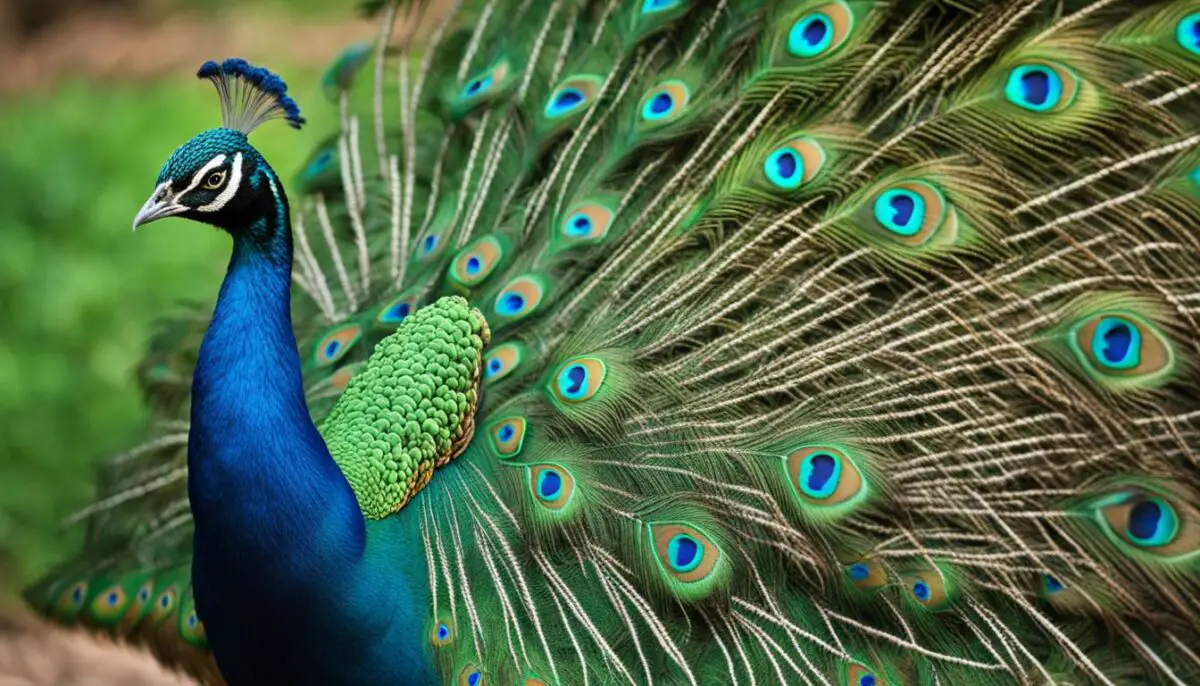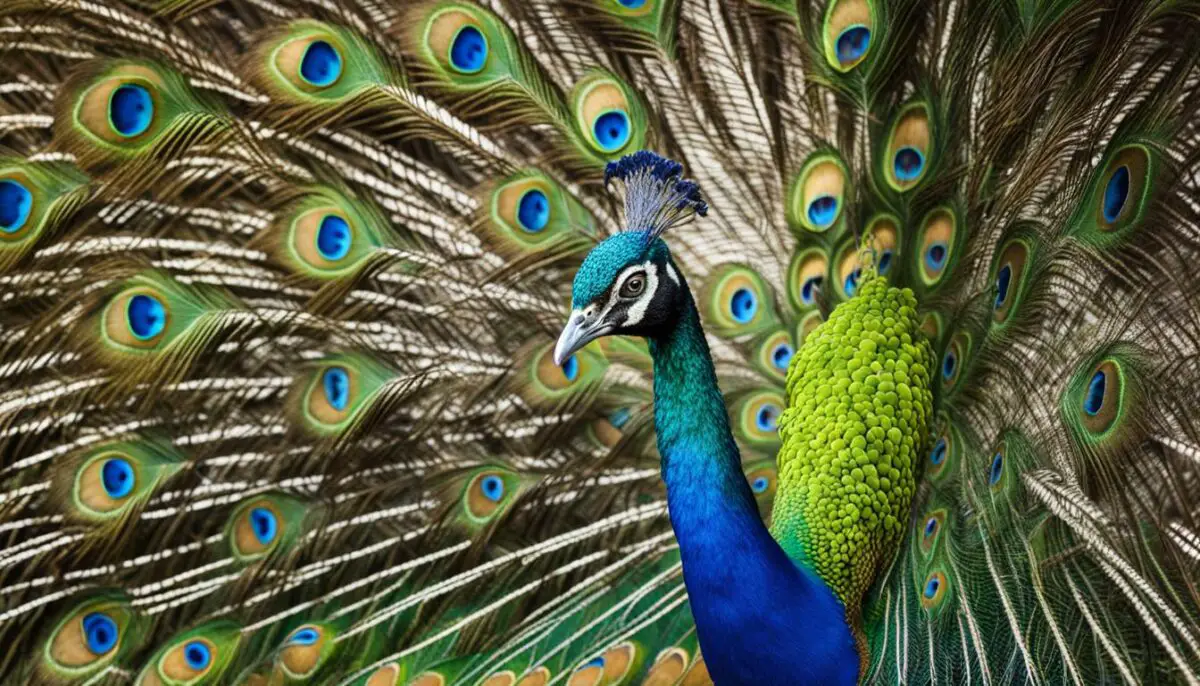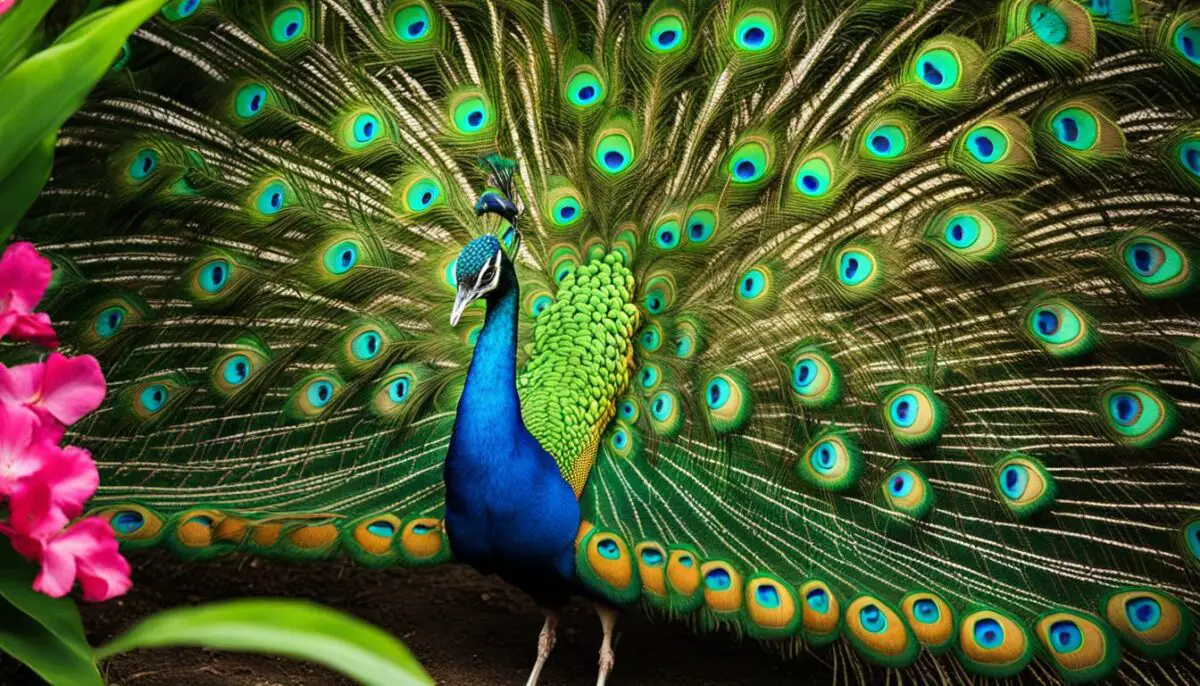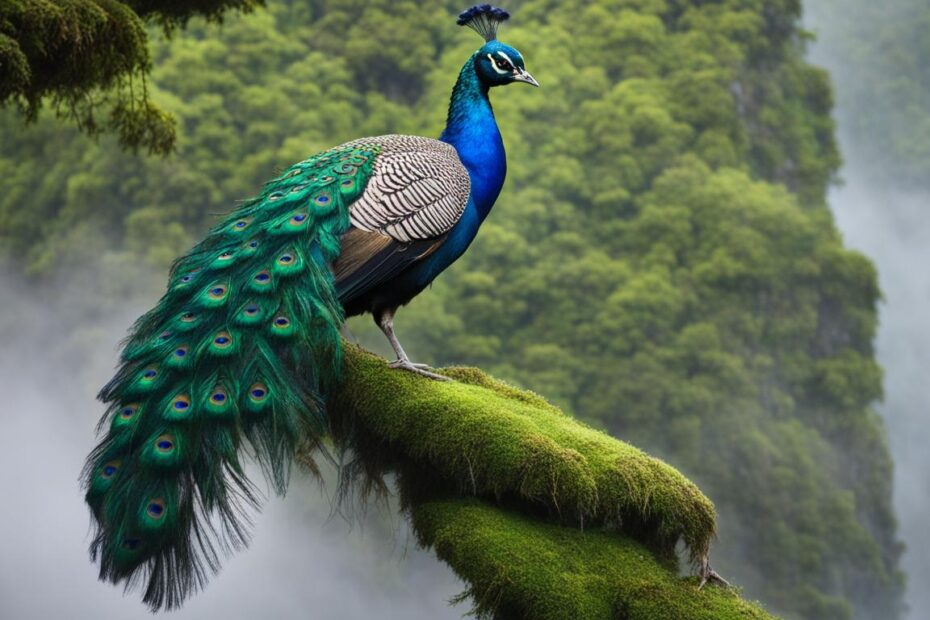Peacocks are known for their glamorous appearance and are considered one of the most stunning birds in the world. Their vibrant feathers and unique plumage have captivated the imagination of people for centuries. While blue and green are the colors commonly associated with peacocks, there is a diverse range of color variations that exist within this species.
From rare and exotic colors to multicolored hybrids, peacocks showcase a remarkable array of hues that are truly awe-inspiring. Breeding programs and genetic mutations have played a significant role in creating these distinct peacock colors, adding to the beauty and diversity of these magnificent birds.
As we delve into the world of different color peacocks, we explore the fascinating variations, the species they belong to, and where you can see these vibrant birds in all their glory. Let’s embark on this mesmerizing journey and uncover the wonders of the colorful peacock species.
Key Takeaways:
- Peacocks are known for their glamorous appearance and vibrant feathers.
- There are 15 documented color variations of peacocks.
- Breeding programs and genetic mutations have contributed to the development of unique peacock colors.
- Peacocks belong to three distinct species: Indian Peafowl, Green Peafowl, and Congo Peafowl.
- Seeing different color peacocks in the wild is rare, but they can be found in breeding farms and specialized collections.
How many peacock species are there?
Peacocks are not just a single species; they are part of a diverse family of birds with different species. There are three distinct species of peacocks that are commonly known: the Indian Peafowl, the Green Peafowl, and the Congo Peafowl.
The Indian Peafowl, scientifically known as Pavo cristatus, is the most well-known species. It is also referred to as the Blue Peafowl or Common Peafowl. This species is native to the Indian subcontinent and is famous for its vibrant blue and green feathers.
The Green Peafowl, scientifically known as Pavo muticus, is native to Southeast Asia. It is also called the Indonesian Peafowl. Unlike the Indian Peafowl, the Green Peafowl has a more subdued coloration, with shades of green and bronze in its plumage.
The Congo Peafowl, scientifically known as Afropavo congensis, is the only peafowl species native to Africa. It is found primarily in the Congo Basin and has unique characteristics such as a vibrant blue breast and lower parts, along with a mix of green, blue, and violet feathers.
| Peacock Species | Scientific Name | Native Region |
|---|---|---|
| Indian Peafowl (Blue Peafowl) | Pavo cristatus | Indian subcontinent |
| Green Peafowl (Indonesian Peafowl) | Pavo muticus | Southeast Asia |
| Congo Peafowl (African Peafowl) | Afropavo congensis | Congo Basin (Africa) |
These three unique peafowl species showcase the rich diversity of peacocks around the world, each with its own distinct beauty and characteristics.
Different Colors of Peacocks
Peacocks are renowned for their stunning colors and extravagant plumage. While blue and green are the most commonly associated colors, there are actually 13 other documented color variations of peacocks. These vibrant and rare hues add to the allure of these magnificent birds, making them even more fascinating to observe and admire.
The different color variations in peacocks are a result of genetic mutations and selective breeding. Through these processes, breeders and researchers have successfully developed unique color combinations, creating peacocks with plumage that ranges from deep purples to soft peaches and even striking whites. Each color variety possesses its own distinct beauty, adding to the diverse palette of the peacock species.
Here is a table showcasing some of the different color variations and their unique characteristics:
| Color Variation | Description |
|---|---|
| Purple | Deep, rich purple feathers with hints of blue and green. |
| Peach | Soft, peachy feathers with a delicate and warm undertone. |
| White | Pure white feathers that create an elegant and ethereal appearance. |
| Cameo | Unique blend of brown and cream feathers, resembling a delicate cameo. |
| Charcoal | Dark, smoky gray feathers with a mysterious and alluring allure. |
| Opal | Iridescent feathers that radiate a spectrum of colors, resembling the gemstone opal. |
These are just a few examples of the mesmerizing colors that peacocks can exhibit. Each color variation adds a touch of uniqueness and charm to the already captivating presence of these birds. Observing and appreciating the different color peacocks is a visual delight that highlights the diversity and beauty of nature.
Where can we see different color peacocks?
While blue and green peacocks can be commonly found in various regions, including India, Sri Lanka, and Southeast Asia, seeing different color peacocks in the wild is extremely rare. These color variations are often seen in breeding farms or specialized collections. If you are interested in seeing different color peacocks, it is recommended to visit these types of establishments or explore breeding programs dedicated to preserving and showcasing these unique and rare peacock varieties.
One popular destination for experiencing the beauty of different color peacocks is the National Aviary in Pittsburgh, Pennsylvania. The Aviary is home to a diverse collection of peafowl, including rare color variations such as White, Cameo, and Opal. Visitors can observe these stunning birds up close and learn about their unique characteristics and breeding efforts.
In addition to the National Aviary, there are also various private collections and zoos around the world that house different color peacocks. Notable examples include the Los Angeles County Arboretum and Botanic Garden, which has a vibrant peafowl population, and the Singapore Zoo, where visitors can encounter a range of colorful peafowl species. These establishments provide a wonderful opportunity to admire and appreciate the exquisite beauty of exotic colored peacocks.
| Location | Notable Features |
|---|---|
| National Aviary – Pittsburgh, Pennsylvania | Diverse collection of rare color variations |
| Los Angeles County Arboretum and Botanic Garden – Los Angeles, California | Vibrant peafowl population |
| Singapore Zoo – Singapore | Various colorful peafowl species |
These are just a few examples of the locations where different color peacocks can be seen. It’s important to note that availability may vary, so it’s recommended to check with the specific establishment before visiting to ensure the desired peacock varieties are on display.
Do female peacocks have colorful feathers?
Female peacocks, also known as peahens, may not have the vibrant plumage and long trains like their male counterparts, but they possess their own unique beauty. While male peacocks use their colorful feathers to attract mates, the purpose of female peacocks’ more subdued feathers is not solely for display. Instead, these feathers serve a more practical function, providing camouflage and protection from predators when they are nesting or caring for their young.
Though lacking the eye-catching colors of male peacocks, peahens showcase a remarkable level of intricate feather detail. Their feathers often feature a mix of shades including various browns, greens, and iridescent hues, which may appear duller when compared to the radiant blues and greens of male plumage, but possess a subtle elegance all their own. The intricate patterning and delicately blended colors contribute to the overall beauty and grace of the female peacock.
It is essential to appreciate both the male and female peacocks for their individual traits that complement each other in the natural world. While the males’ colorful displays are mesmerizing, the peahens have their own distinctive allure. Together, they ensure the continuation of the species by attracting mates and participating in the vital process of reproduction.
The Unique Role of Peahens in Peacock Courtship
In the elaborate courtship displays of peacocks, the male’s colorful feathers steal the show. However, the peahens play a crucial role in choosing a mate based on factors beyond visual appearance. Peahens observe the males’ behavior, health, and overall fitness, evaluating their potential as partners and providers. This focus on selecting a suitable mate highlights the significance of the peahens’ role in ensuring the survival and genetic diversity of the species.
Peacock Vs Peahen – Indian Peafowl
The Indian peafowl, also known as the Blue Peafowl or Common Peafowl, is a species that displays significant differences between males, or peacocks, and females, or peahens. These differences are primarily seen in their physical appearances and behaviors.
The peacock is famous for its iridescent blue plumage and long, elaborate train, which consists of elongated upper-tail covert feathers. The train is used as a display during courtship to attract peahens. The peacock will spread its train into a magnificent fan and quiver it, creating a mesmerizing sight for the peahens.
In contrast, the peahens have a more subdued plumage with shades of brown and green. They lack the long train and vibrant colors of the peacock. Instead, their focus is on selecting a mate based on other factors such as behavior and overall health and fitness.

In summary, the Indian peafowl showcases clear distinctions between the males and females. The peacock’s striking plumage and magnificent train serve as a visual spectacle during courtship, while the peahens possess a more subtle beauty. These differences contribute to the intricate dynamics of the Indian peafowl species, highlighting the fascinating diversity of the natural world.
Peacock Vs Peahen – Green Peafowl
The Green Peafowl, also known as the Indonesian Peafowl, is a majestic bird that showcases stunning colors and fascinating behavior. Let’s explore the differences between the males, known as peacocks, and the females, called peahens, of this unique species.
Physical Appearance
Green peafowls display iridescent green necks and breasts, which is a shared feature between males and females. However, during the breeding season, male peacocks develop an elaborate train that consists of long, vibrant feathers. This train is used to attract the attention of peahens during courtship displays. In the non-breeding season, the train is molted, making it difficult to differentiate between males and females solely based on physical appearance.
Behavior
In addition to their physical appearance, the behavior of green peafowls also reveals distinct differences between males and females. During courtship, male peacocks perform elaborate displays, including spreading their train and fanning their feathers. These displays are accompanied by vocalizations and shaking movements to allure peahens. Peahens, on the other hand, are more selective when choosing a mate and are observed to pay attention to factors such as behavior and overall health and fitness.
| Male (Peacock) | Female (Peahen) |
|---|---|
| Develops an elaborate train | No train |
| Displays courtship behavior | Selective in choosing a mate |
| Green neck and breast | Green neck and breast |
Overall, the Green Peafowl showcases remarkable sexual dimorphism, with males exhibiting extravagant displays and features to attract the attention of females. Understanding the differences between peacocks and peahens in this species provides deeper insight into their fascinating biology and behavior.
Peacock Vs Peahen – Congo Peafowl
The Congo peafowl, also known as the African peafowl, exhibits distinct physical differences between males and females. These differences play a crucial role in attracting mates and maintaining genetic diversity within the species. Let’s explore the unique characteristics of both peacocks and peahens in the Congo Peafowl population.
Male Congo Peafowl (Peacock)
Male Congo peafowls have vibrant and striking plumage. Their feathers are a mix of green, blue, and violet, creating a mesmerizing display. The males also have a red throat skin, white crests, and iridescent blue breasts and lower parts. These colorful features make them highly attractive to peahens during mating season. The male’s elaborate appearance showcases their health, vigor, and ability to acquire resources, making them desirable mates.
Female Congo Peafowl (Peahen)
Female Congo peafowls, in contrast, have a more subtle appearance compared to the males. They mainly have brown feathers, with black lower bodies embellished with green flecks. The peahens’ plumage provides natural camouflage, helping them blend into their surroundings and ensuring their safety from predators while nesting. The females evaluate potential mates based on their behavior, courtship displays, and overall health rather than relying solely on physical appearance.
| Physical Characteristics | Peacock (Male) | Peahen (Female) |
|---|---|---|
| Feather Colors | Green, blue, violet | Brown with black lower bodies adorned with green flecks |
| Throat Skin Color | Red | N/A |
| Crest Color | White | N/A |
| Main Attraction Mechanism | Colorful plumage, elaborate displays | Behavior, courtship displays, overall health |
In conclusion, the physical differences between male and female Congo peafowls contribute to their unique courtship rituals and reproductive success. While the males mesmerize with their vibrant plumage and intricate displays, the females play a vital role in selecting suitable mates based on multiple factors. Together, they ensure the continuation and genetic diversity of the Congo peafowl species.

Conclusion
In conclusion, while pink and red peacocks do not exist in nature, there are 15 documented color variations of peacocks that showcase their incredible diversity. These color variations are the result of genetic mutations and selective breeding, adding to the allure of these magnificent birds. Although seeing these unique color variations in the wild is extremely rare, breeding farms and specialized collections offer the opportunity to witness the beauty of different color peacocks up close.
Peafowls continue to captivate and inspire awe with their vibrant feathers. Whether it’s the opulent blue and green plumage of the Indian Peafowl, the iridescent green feathers of the Green Peafowl, or the distinct mix of colors found in the Congo Peafowl, each species showcases its own distinctive beauty. The detailed and striking patterns on the feathers further highlight the colorful nature of peacocks, making them a sight to behold.
The world of colorful peacock species is both fascinating and enchanting. With ongoing research and breeding programs, who knows what the future may hold? Perhaps one day, we may even witness the existence of entirely new color variations, including pink or red peacocks. Until then, we can appreciate the existing color variations and marvel at the intricate beauty found in these magnificent birds.
Amazing Facts about Peacocks
Peacocks are truly fascinating creatures with a multitude of unique characteristics. Here are some amazing facts about these magnificent birds:
Spectacular Visual Displays
One of the most striking aspects of peacocks is their stunning visual displays during courtship. The male peacock, or peafowl, will raise its long and vibrant train, quivering in an elaborate dance to attract the attention of the female peahens. This mesmerizing display of colors and movement is a sight to behold.
Omnivorous Appetite
Peafowls have a diverse diet as they are omnivorous creatures. They consume a variety of foods, including seeds, fruits, grains, and insects. This adaptable diet allows them to thrive in various habitats and ensures they have a sufficient intake of nutrients to maintain their health and vitality.
“Their vibrant feathers continue to mesmerize and inspire awe in people all over the world.”
Sacred Symbolism
Peacocks hold significant symbolic meanings in various cultures and mythologies. In many traditions, peacock feathers are associated with beauty, royalty, spirituality, and protection. They are believed to represent awakening, intuition, and the opening of the third eye. These feathers are also considered lucky and are believed to bring positive energy and abundance.
| Fact | Description |
|---|---|
| Flight Abilities | Despite their long and seemingly cumbersome trains, peacocks are excellent flyers. They can soar through the air with grace and agility, reaching impressive speeds of up to 10 miles per hour. |
| Cultural Significance | Peacocks hold a special place in many cultures around the world. They are often depicted in art, literature, and religious rituals, symbolizing beauty, wisdom, immortality, and spirituality. |
| Distinctive Calls | Peacocks have a unique vocalization that is loud and distinct. The male peafowl emits a resonant call, known as a “peacock’s scream,” which serves as a means of communication and to establish territory. |
Peacocks are truly captivating creatures, captivating our hearts with their brilliant displays and intriguing characteristics. Their adaptability, symbolism, and stunning appearance make them a fascinating and beloved species in the natural world.

Peacock Feather Meaning
Peacock feathers have long been regarded as symbols of beauty, royalty, and spirituality in various cultures around the world. These exquisite feathers hold deep symbolic meaning and are often associated with positive qualities and energies.
In many spiritual traditions, peacock feathers are believed to represent awakening and spiritual growth. They are seen as a symbol of inner wisdom, intuition, and the opening of the third eye. The mesmerizing patterns and vibrant colors of peacock feathers are thought to inspire creativity and enhance one’s connection with the divine.
Additionally, peacock feathers are considered a symbol of protection and good luck. They are believed to ward off negative energies and bring positive energy into the surroundings. Placing peacock feathers in the home or wearing them as accessories is thought to bring abundance, prosperity, and harmony.
Overall, the symbolic meaning of peacock feathers encompasses not only their visual beauty but also their ability to evoke a sense of wonder and connection to the spiritual realm. These feathers serve as a reminder to embrace one’s inner beauty, express creativity, and stay connected to the divine forces that surround us.
FAQ
Are there pink or red peacocks?
No, there are no records of pink or red peacocks. The closest to pink in color is the peach peacock, but currently, these colors do not exist in nature.
How many species of peacocks are there?
There are three distinct species of peacocks: the Indian Peafowl, the Green Peafowl, and the Congo Peafowl.
What are the different colors of peacocks?
There are 15 color variations of peacocks, including purple, peach, white, cameo, charcoal, opal, Buford bronze, midnight, jade, and others.
Where can we see different color peacocks?
Different color peacocks can be seen in breeding farms and specialized collections, as they are extremely rare to find in the wild.
Do female peacocks have colorful feathers?
No, female peacocks, also known as peahens, have more subdued feathers in shades of brown and green.
What is the difference between a peacock and a peahen in the Indian Peafowl species?
Male peacocks have iridescent blue plumage with long trains, while female peahens have more subdued brown feathers.
What is the difference between a peacock and a peahen in the Green Peafowl species?
Both male and female Green Peafowls have iridescent green necks and breasts, but males have a longer train during the breeding season.
What is the difference between a peacock and a peahen in the Congo Peafowl species?
Male Congo Peafowls have red throat skin, white crests, and iridescent blue breasts, while females have mainly brown feathers with green flecks.
Are there any pink or red peacocks?
Currently, there are no pink or red peacocks in nature. However, there are 15 documented color variations of peacocks.
What are some interesting facts about peacocks?
Peacocks are known for their stunning courtship displays, omnivorous diet, and symbolic meanings in various cultures and mythologies.
What is the meaning of peacock feathers?
Peacock feathers are often associated with beauty, spirituality, and protection. They are believed to represent awakening, intuition, and good luck.


